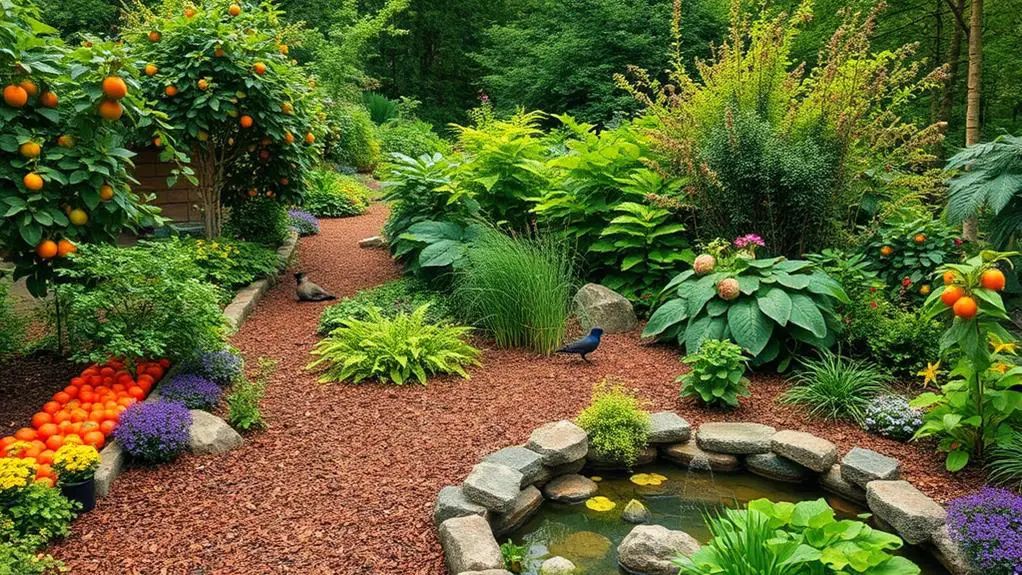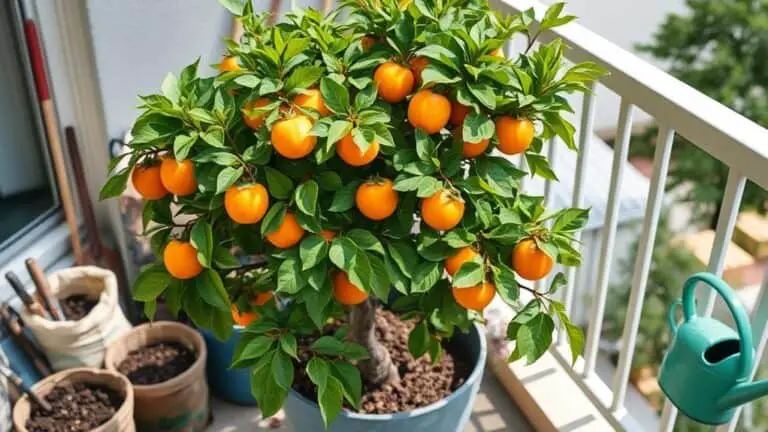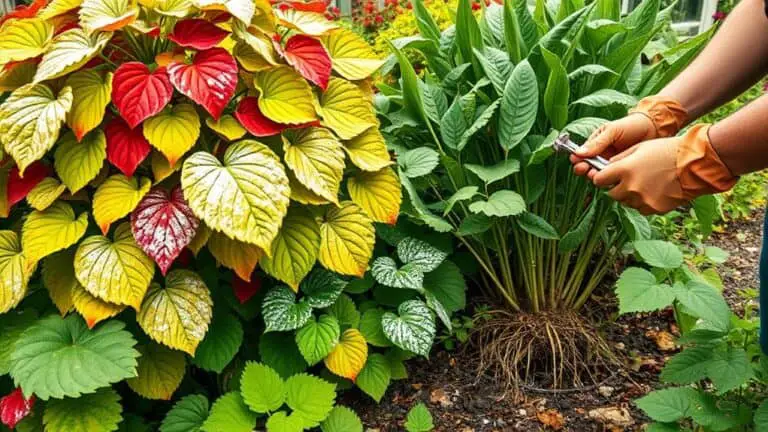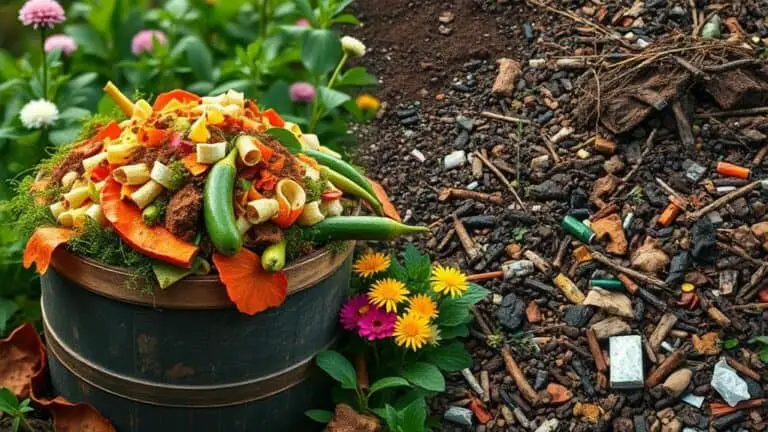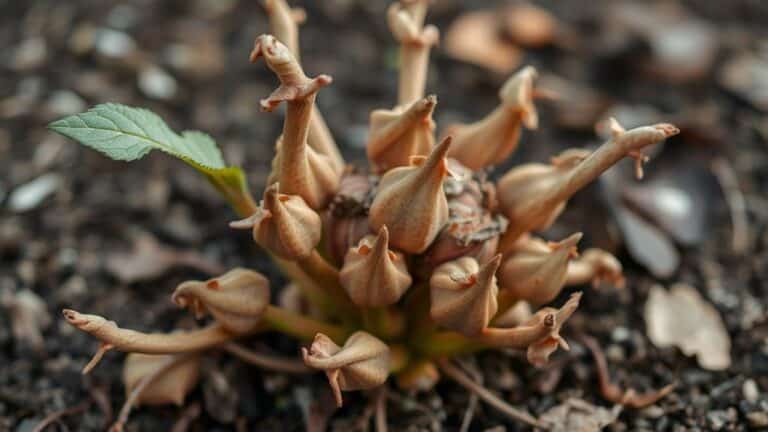How To Grow A Permaculture Food Forest In Your Yard
When I first considered transforming my yard into a permaculture food forest, I realized it wasn't just about planting a few fruit trees and hoping for the best. Understanding the ecosystem's layers—from the towering canopy to the ground cover—was vital. I had to select a mix of native and drought-resistant plants that could thrive in my local climate. Conducting a thorough site assessment and preparing the soil with techniques like sheet mulching were essential steps. But how do you maintain such a system and attract beneficial wildlife to support it? Let's explore these aspects in more detail.
Understanding Food Forests
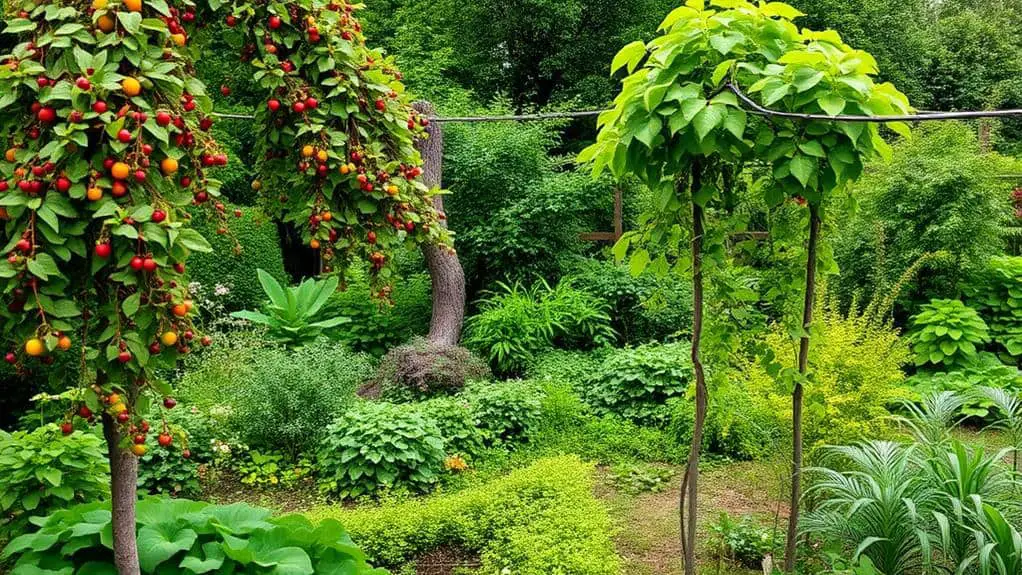
A food forest, designed to mimic natural forest ecosystems, is a self-sustaining gardening method that layers different types of plants to work together harmoniously.
In a food forest, we use permaculture principles to create an edible landscape. This involves food forest guilds, where a central tree, like a fruit tree, is surrounded by companion plants. These can include nitrogen-fixing shrubs, ground cover plants, and herbs that help improve the soil and support the main tree.
Benefits of Food Forests
When it comes to gardening, food forests offer a myriad of benefits that far surpass traditional methods.
First, food forests can yield 3-5 times more food due to their diverse plant layers and resilient ecosystems. They enhance soil fertility naturally, reducing the need for synthetic fertilizers and promoting sustainable gardening practices.
These gardens also provide habitat for beneficial insects, aiding in natural pest control. By incorporating various plant species, food forests improve resilience against pests and diseases, ensuring stable yields throughout the growing season.
Additionally, they create a self-maintaining food source that requires minimal intervention once established. The organic matter in food forests helps retain soil and prevent evaporation, contributing to long-term sustainability.
Setting Goals
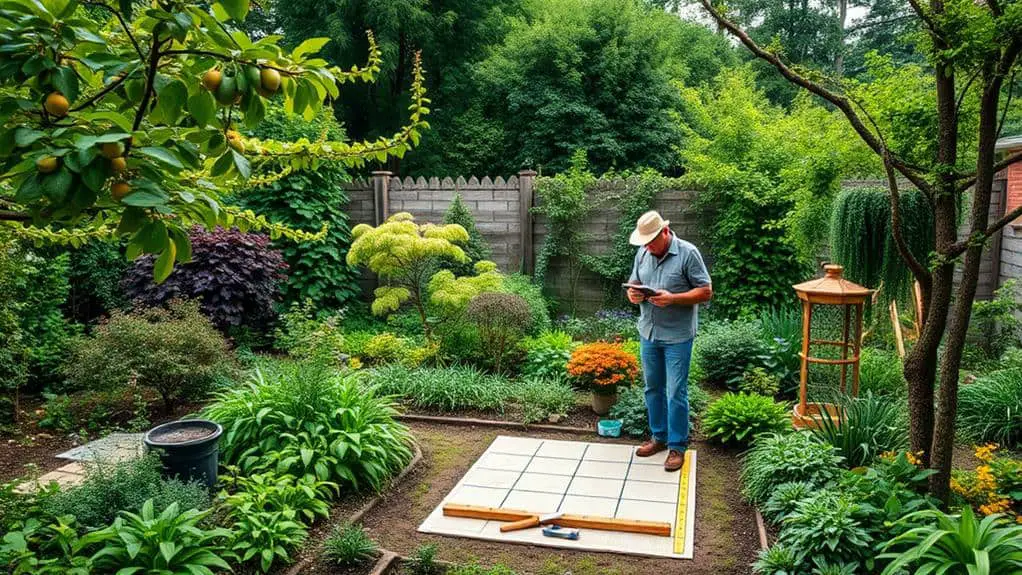
Before starting your food forest, it's essential to define your goals.
Think about whether you want to become more self-reliant, make some extra income, or use this space for learning and teaching.
Once you've set your objectives, consider which crops will best support those goals and fit well with your available time and resources.
Define Your Objectives
Defining your objectives is essential to the success of your permaculture food forest, as clear goals will guide every step of the planning and implementation process.
First, think about what you want to achieve. Are you aiming for self-reliance, income generation, or education? Your goals will shape your food forest's design and the resources you'll need.
It's helpful to prioritize specific objectives to keep your focus clear. Consider the diversity of crops you want, like fruits, nuts, herbs, and vegetables, and how they fit with your local climate and soil.
Also, don't forget to factor in your time and financial resources. Stay flexible and adapt as you learn from your ecosystem.
That way, you'll create a thriving, sustainable food forest.
Determine Desired Crops
Choosing the right crops for your permaculture food forest begins with understanding your specific goals and the unique conditions of your site. First, establish clear objectives—self-reliance, income, or education—that will guide your crop choices. Assess your local climate and soil conditions to determine desired crops that will thrive, such as native and drought-resistant varieties. Aim for a diverse range of plants, including fruits, nuts, herbs, and vegetables, to create a balanced permaculture garden. Incorporate nitrogen fixers like Siberian pea shrubs to boost soil fertility. Regularly revisit your choices based on observations to keep the ecosystem productive and diverse.
| Crop Type | Example Plant | Benefits |
|---|---|---|
| Fruit | Apple Tree | Provides food, shade |
| Nut | Hazelnut Bush | High protein, resilient |
| Herb | Rosemary | Culinary, medicinal uses |
| Nitrogen Fixer | Siberian Pea Shrub | Enhances soil fertility |
| Perennial Veg | Asparagus | Low maintenance, edible |
Creating a thriving food forest is an ongoing, rewarding process!
Site Assessment
Starting your permaculture food forest begins with a thorough site assessment, an essential step to guarantee your project thrives.
Start with a site survey by spending 5-50 minutes quietly observing your yard. Take note of soil type, water availability, and existing wildlife interactions.
Use technology like weather pattern tools and terrain analysis apps to gather detailed information about your site's microclimate and landscape features.
Create hand-drawn or thematic maps to visualize your observations, which will help in your permaculture design.
Focus on improving soil health incrementally. Start with one patch at a time, using mulching and organic amendments to boost fertility.
This careful planning assures your food forest will be healthy and productive.
Soil Preparation

After thoroughly evaluating your site, the next step is soil preparation, a foundational task that guarantees your food forest will thrive.
Start by analyzing your soil type, pH, and existing vegetation. This helps you know what amendments are needed.
Use sheet mulching techniques by layering cardboard and organic materials to improve soil quality, retain moisture, and suppress weeds.
Incorporate organic matter like compost and wood chips to enhance soil structure and boost fertility. You can also add rabbit manure or other nitrogen-rich amendments.
Monitoring soil moisture levels is essential—make sure the soil is adequately moist before adding thick layers of mulch or wood chips.
This preparation sets the stage for healthy perennial plants in your food forest.
Designing Your Food Forest
How do you transform a simple piece of land into a thriving permaculture food forest? Start with a thoughtful design process.
Utilize the layers of the forest by planting tall canopy trees, smaller fruit trees, shrubs, herbs, and ground cover to maximize vertical space and enhance biodiversity.
Assess sunlight exposure, soil quality, and water availability to choose plants suited to your conditions.
Create plant guilds by pairing compatible species, like nitrogen-fixing plants with fruit trees, to boost growth.
Plan pathways for easy access, considering plant sizes to prevent overcrowding.
Use water management techniques such as swales to retain moisture and reduce runoff.
Selecting Plants
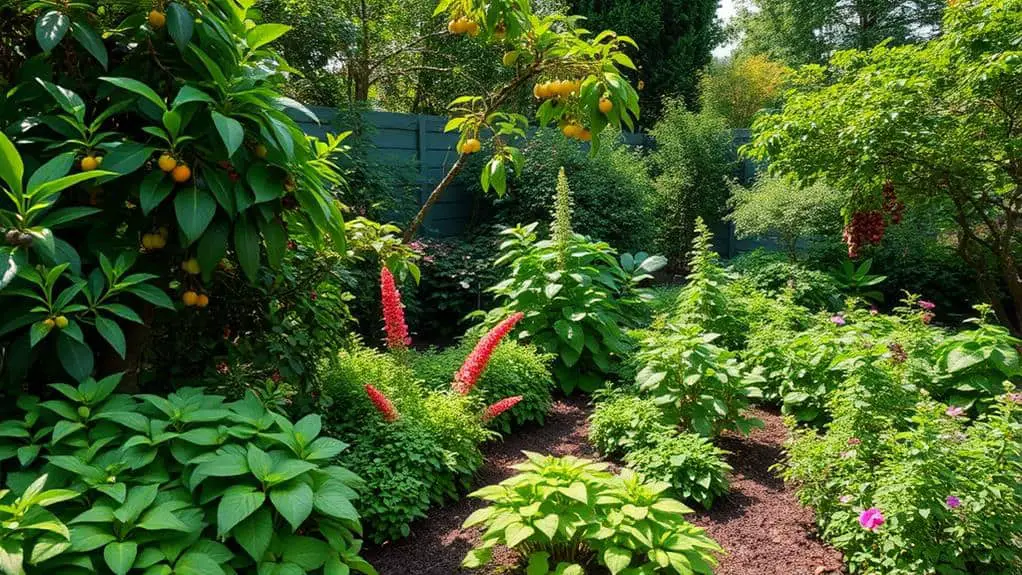
Choosing the right plants is essential for establishing a successful permaculture food forest. Start by prioritizing native and drought-resistant species that thrive in your climate, like Leadtree and Moringa in South Texas.
Incorporate a mix of layers, including canopy trees, shrubs, and herbs, to maximize vertical space and enhance biodiversity. Opt for disease-resistant varieties and nitrogen-fixing plants like the Siberian Pea shrub to improve soil health.
To prevent overcrowding, assess the mature size of trees and shrubs, ensuring they get enough sunlight and airflow. Experiment with companion planting by combining species that support each other.
For instance, plant ground cover legumes alongside fruit trees to boost soil fertility and biodiversity. This thoughtful selection will foster a thriving, resilient ecosystem.
Planting Techniques
Planting techniques play an essential role in establishing a thriving permaculture food forest. First, use sheet mulching to prepare the soil. Layer cardboard and organic materials to retain moisture and improve soil quality over time.
Assess the mature size of trees and shrubs to avoid overcrowding, ensuring all plants get enough sunlight and airflow. Include nitrogen-fixing plants to boost soil fertility and support ecosystem health.
Plant in diverse layers—canopy trees, understory plants, and ground covers—to maximize space and promote biodiversity. Don't forget to add edible herbs for extra benefits.
Maintenance Tips

Maintaining a permaculture food forest involves consistent observation and hands-on care to guarantee its long-term health and productivity.
First, regularly monitor plant health and growth patterns to see which species thrive. Adjust as needed for ideal productivity.
Implement organic mulching with wood chips or pine straw to keep soil moist, suppress weeds, and enhance soil health.
Nitrogen-fixing plants like Siberian pea shrubs will naturally improve soil fertility, reducing the need for synthetic fertilizers.
Seasonal pruning of fruit trees and shrubs is essential for good airflow and sunlight, helping them produce healthy fruit.
Finally, attract beneficial insects and wildlife, such as ladybugs and toads, to manage pests naturally.
Your food forest will flourish with these maintenance tips.
Community Resources
As you actively maintain your permaculture food forest, tapping into community resources can greatly enhance your efforts.
Local permaculture groups often host workshops, giving you hands-on learning and access to experienced practitioners. These experts share valuable tips on food forest design and maintenance.
Community gardens are also great places to observe permaculture food forests in action and collaborate with fellow gardeners.
Don't forget online platforms and forums; they're perfect for sharing ideas and tackling regional challenges.
Seed exchanges can help you find native and heirloom species ideal for permaculture.
Even local universities and extension services offer resources, research, and guidance.
Frequently Asked Questions
How to Start a Backyard Food Forest?
To start a backyard food forest, I assess sunlight, soil health, and water management. Then, I create a design using companion planting and native species. I focus on seasonal planting, pest control, and maintenance strategies for ongoing success.
How Do I Turn My Yard Into Permaculture?
To turn my yard into permaculture, I'd follow permaculture principles, focusing on companion planting and soil health. I'd choose native plants, manage water efficiently, and create wildlife habitats. This fosters biodiversity benefits and offers seasonal harvests.
How to Create a Forest in the Backyard?
To create a forest in your backyard, start with forest layers and native plants. Focus on companion planting for soil health and wildlife habitat. Implement water management, grow seasonal crops, and embrace biodiversity benefits for a thriving ecosystem.
How Do I Start a Food Garden in My Backyard?
To start a food garden, I assess my backyard, focusing on garden design and soil health. I use companion planting and native species to boost growth. Seasonal crops, effective water management, and natural pest control guarantee a fruitful harvest.
Conclusion
Creating a permaculture food forest in your yard is a rewarding journey. By understanding the ecosystem, preparing the soil, and choosing the right plants, you can create a thriving, self-sustaining garden. Remember to regularly maintain your forest and welcome beneficial wildlife. Don't worry if it seems challenging at first; each step you take brings you closer to your goal. Stay patient and enjoy the process. You've got this, and your garden will thank you!

